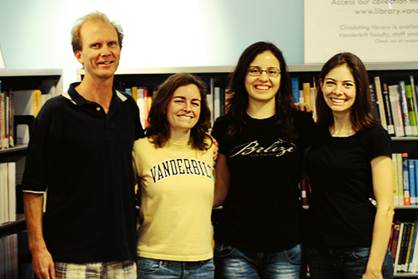Teaching-as-Research Fellows Share Completed Projects
As part of the national Center for the Integration of Research, Teaching and Learning (CIRTL) Network activities at Vanderbilt, the CFT co-sponsors the Teaching-as-Research (TAR) Fellows program for graduate students and post-doctoral fellows in the STEM (science, technology, engineering, mathematics) fields. This year, four TAR Fellows completed projects exploring aspects of undergraduate education in their disciplines. Each Fellow worked with a faculty instructor of an undergraduate course. On April 10 the Fellows presented their research results at a CIRTL national online poster session that involved the Fellows at the other CIRTL institutions.

Tamara Carley’s project involved EES 225, Earth Materials, with instructor Guilherme Gualda. Students were asked to use Prezi to create a comprehensive, cohesive, and organized representation of knowledge gained throughout the semester in the style of an interactive concept map with zooming capabilities. Special emphasis was placed on recognizing and representing the relationships between the micro‐, macro‐and megascopic aspects of Earth Materials. This project, which need not be geologically-specific, will be implemented again as the investigators found it valuable for teaching and learning the mastery of multi-scale concepts. View the poster for Tamara’s project.
Fluid momentum has proven to be one of the toughest concepts to grasp in fluid mechanics. Mike Myers and his course instructor, Haoxiang Luo, hypothesized that by using challenge-based learning along with a hands-on demonstration, students would develop a deeper and richer understanding of fluid momentum concepts in ME 224, Fluid Mechanics. The challenge-based approach included a short video clip of a fire hose moving out of control from a firefighter’s grasp during a training exercise and a hands-on demonstration involving 250 ml squeeze bottles filled with water. Survey results indicated the challenge question involving a real-world firefighter problem engaged the students from the start and helped connect the material as the students were learning. Mike presented a paper on his project at the national meeting of the American Institute of Aeronautics and Astronautics. View the paper about Mike’s project.
The project of Elizabeth Adolph, Margarita Pietro and instructor Scott Guelcher involved cooperative learning and its effects on the academic achievement and interest level of major and non-major students in an introductory engineering course, ES 140. All the engineering first-year students take this class, and they choose 3 modules to take during the semester to learn about 3 different engineering fields. In the classroom, three different cooperative learning strategies were implemented: (a) allowing students to self-select their working teams, (b) grouping chemical engineering students together and non-chemical engineering students together (homogeneous groups), and (c) grouping chemical engineering students and non-chemical engineering students together (heterogeneous groups). The investigators hypothesized that the overall interest level and academic achievement of students working in heterogeneous groups would be higher than that of the students working in homogeneous groups due to the exposure of the non-major students to the views and perspectives of the major students. Survey and quiz results indicated that there were no significant differences in scores from Modules 1, 2, and 3 or between chemical engineers and non-chemical engineers within each module. View Margarita and Elizabeth’s project poster.
CIRTL is funded through the Division of Undergraduate Education of the National Science Foundation.

Leave a Response